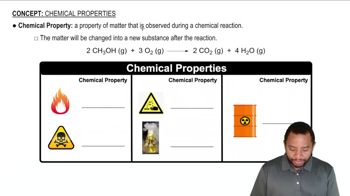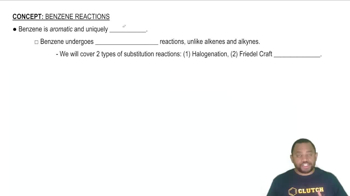How many kilograms of CO2 does the complete combustion of 3.8 kg of n-octane produce?
Ch.22 - Organic Chemistry
Chapter 22, Problem 100d
Determine the products of each reaction. d.
 Verified step by step guidance
Verified step by step guidance1
Identify the type of chemical reaction given in the problem. Common types include synthesis, decomposition, single replacement, double replacement, and combustion.
Write down the reactants involved in the reaction. If the problem does not specify, use a placeholder or generic formula to represent them.
Apply the rules for predicting products based on the type of reaction. For example, in a double replacement reaction, the cations and anions of the reactants switch places.
Balance the chemical equation by ensuring that the number of atoms for each element is the same on both sides of the equation.
Verify the physical states of the products (solid, liquid, gas, aqueous) if possible, based on solubility rules or given information.

Verified video answer for a similar problem:
This video solution was recommended by our tutors as helpful for the problem above.
Video duration:
1mWas this helpful?
Key Concepts
Here are the essential concepts you must grasp in order to answer the question correctly.
Chemical Reactions
A chemical reaction involves the transformation of reactants into products through the breaking and forming of chemical bonds. Understanding the types of reactions, such as synthesis, decomposition, single replacement, and double replacement, is essential for predicting the products formed in a given reaction.
Recommended video:
Guided course

Chemical Properties
Balancing Chemical Equations
Balancing chemical equations is crucial for ensuring that the law of conservation of mass is upheld, meaning that the number of atoms of each element must be the same on both sides of the equation. This process helps in accurately determining the stoichiometry of the reaction and the proportions of reactants and products involved.
Recommended video:
Guided course

Balancing Chemical Equations
Reaction Conditions
The conditions under which a reaction occurs, such as temperature, pressure, and the presence of catalysts, can significantly influence the products formed. Understanding these conditions helps in predicting the outcome of reactions and optimizing them for desired results.
Recommended video:
Guided course

Benzene Reactions
Related Practice
Textbook Question
Textbook Question
Classify each organic reaction as combustion, alkane substitution, alkene addition or hydrogenation, aromatic substitution, or alcohol substitution, elimination, or oxidation.
c.
Textbook Question
Classify each organic reaction as combustion, alkane substitution, alkene addition or hydrogenation, aromatic substitution, or alcohol substitution, elimination, or oxidation.
d.
Textbook Question
Draw the structure that corresponds to each name and indicate which structures can exist as stereoisomers. a. 3-methyl-1-pentene b. 3,5-dimethyl-2-hexene c. 3-propyl-2-hexene
1
rank
Textbook Question
Identify the two compounds that display stereoisomerism and draw their structures. a. 3-methyl-3-pentanol b. 2-methyl-2-pentanol c. 3-methyl-2-pentanol d. 2-methyl-3-pentanol e. 2,4-dimethyl-3-pentanol
